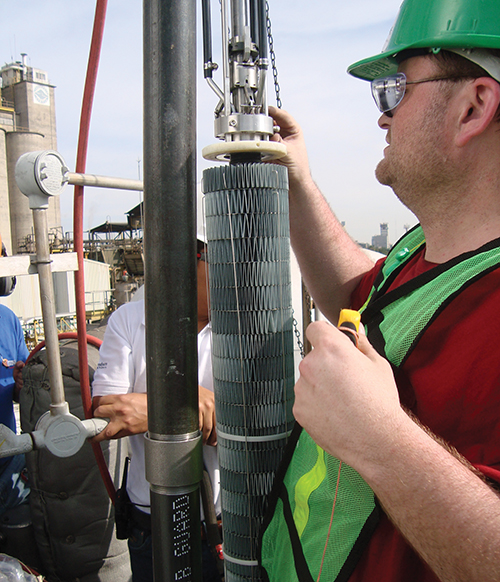
Reactors Save Energy, Costs for Hydrogen Production
NASA Technology
When flying, do you ever wonder how the electronics—lights, air vents, or WiFi—continue to function as you glide across the sky? Commercial aircraft supply their own power with batteries; auxiliary power units (APUs, or small engines); and large jet engines.
To save energy and reduce pollution, NASA’s Glenn Research Center examined alternative methods of producing electricity—including fuel cells—onboard commercial aircraft in the early 2000s. APUs are traditionally powered by jet fuel to generate electricity, but Glenn turned to fuel cell APUs, which use hydrogen and oxygen instead. By using fuel cells, the Center estimated a 2-hour commercial flight could save 20 percent on energy.
In looking at fuel cell technology, Glenn also had to look at fuel reforming technology. A fuel reformer uses fuel, air, steam, and a catalyst (reactor), to produce hydrogen for the fuel cell to make electricity. For Glenn’s purposes, the reformer needed to be small, lightweight, and capable of reforming jet fuel to produce hydrogen and carbon monoxide.
Thomas Tomsik, an engineer in the fluid systems branch at Glenn, recalls the work. “When you compared the fuel cell power source versus the current APU, it reduced emissions during taxi, boarding, and while the aircraft was being serviced. Contemporary APUs continuously burn jet fuel, but if you can convert and use hydrogen as a source, it’s cleaner and quieter.”
These catalytic reforming technologies have been studied by Glenn not only for onboard generation of auxiliary power but for other mobile applications as well.
Technology Transfer
During its research, the Glenn team learned about the capabilities of a local company to engineer and manufacture fabricated foil structures that could be coated with custom catalysts for fuel reforming. In 2003, the Center partnered with the manufacturer—Garrettsville, Ohio-based Catacel Corporation—under the Glenn Alliance Technology Exchange program and then through a Space Act Agreement.
Through its work with Glenn, Catacel developed a novel catalytic combustor module called a stackable structural reactor (SSR). About the size and shape of a coffee can, the reactor is comprised of a honeycomb-shaped high-temperature stainless steel foil that can be coated with nickel, rhodium, or other precious metal catalysts. The coating(s) activate the reforming reaction to produce hydrogen.
Catacel engineers and the Glenn research team set up test equipment and a lab for installation of the SSR units and then analyzed the design of the units, suggested modifications, tested the units, and compared them to standard ceramic units.
“We determined that Catacel’s SSR catalyst had about a two times higher heat transfer rate than the commercial ceramic catalyst,” says Tomsik. A higher heat transfer rate means the reforming process can take place at lower temperatures, and the same amount of product can be made using less energy. As a result, the life of the equipment is extended, and significant costs are saved.
Next, Glenn and Catacel tested and modified a near commercial size SSR for industrial hydrogen production, and the unit demonstrated cost savings up to 35 percent, with annual savings in the millions of dollars. After the NASA tests, Catacel carried out additional research and development to perfect its design, which is now available commercially.
Benefits
In 2008, Catacel installed the first commercial version of the NASA spinoff SSR in a hydrogen production plant in Turkey to supply hydrogen for a steel mill. As of 2012, the early-version SSR was continuing to perform just as well as traditional catalytic technology. According to Catacel, the life of the SSR is expected to be as long as the life of the industrial plant in which it is used.
In 2012, a food oils processing plant in Mexico installed Catacel’s newest version of the SSR for hydrogen production. The plant requires large amounts of hydrogen to make sorbitol, a food ingredient, out of corn. According to Catacel, the plant saw an immediate 13.5 percent natural gas cost reduction after installing the technology, which increased to a nearly 30 percent fuel reduction when the plant was run at typical production rates. Thanks to the savings, the plant expects to see a return on its investment in less than 3 years.
Don Lensner, the manager of sales and marketing at Catacel, says the results are impressive. “That plant is producing the same amount of hydrogen as it did before, but using 30 percent less combustion fuel. When you turn down your burners by 30 percent, there’s a significant environmental and economic benefit,” he says.
Lensner believes the SSR will enable new efficiency in commercial hydrogen production across the world in the petrochemical, steel, food, silicon chip, glass, ammonia, and methanol industries.
On average, the technology results in energy savings of about 20 percent. It also enables longer lifetimes for the equipment as well as capital cost savings in new plant designs. “The coating technology is where the heart of our intellectual property is. Our coatings exist under very severe, heavy-duty cycles over long periods of time,” says Lensner.
In the future, the same technology could potentially be used for carbon capture, explains Lensner. Instead of using catalysts to promote a reaction, the coating would contain materials to absorb carbon. Catacel is currently working with the Department of Energy on this application.
As Lensner says, “Government agencies enable industry to innovate and incubate big ideas that they could not possibly approach on their own. They have enabled so many companies, like Catacel, to get involved with the building blocks of new technology.”
The next time you fly, remember how NASA spinoff technology is saving energy—not only for industrial processes but for the Nation as a whole.

The stackable structural reactor (SSR) shown on the right, was installed in 2012 at a food oils processing plant in Mexico for hydrogen production to make sorbitol. Thanks to the SSRs, the plant is producing the same amount of hydrogen as it previously did, but using 30 percent less fuel.

Glenn Research Center examined fuel reformers to produce hydrogen for fuel cells aboard commercial aircraft.













